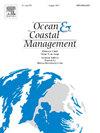基于混合轨迹聚类法的热带气旋波浪特征研究
IF 4.8
2区 环境科学与生态学
Q1 OCEANOGRAPHY
引用次数: 0
摘要
了解具有不同形成机制的不同 TC 轨道类型的活动和波浪特征对海岸和海洋工程至关重要。本研究提出了一种基于代表轨迹形状和影响区域的轨迹指标的混合聚类方法,将中国沿海的 721 条热带气旋轨迹划分为三种轨迹类型。由于自组织图法诊断出的航迹指标具有内在相似性,因此 K-means 法的初始聚类中心点选择是合理的。5000 次聚类试验表明,聚类结果比传统的 K-means 方法更稳健,平均差异百分比从 11.3%下降到 5.5%。通过分析鲁棒聚类结果,研究了大气环流模式背景下三种热带气旋的活动特征以及三种热带气旋产生的波浪特征,尤其是极端波浪的特征。极端波高和波向的联合分布模式表明了不同 TC 类型引起的方向扇形移动和频率变化。这些结果为海岸和海洋工程结构的风险分析和抗灾建设提供了重要启示。本文章由计算机程序翻译,如有差异,请以英文原文为准。
Study of tropical cyclone wave characteristics based on a hybrid track clustering method
Understanding the activity and wave characteristics of different TC track types with different formation mechanisms is crucial for coastal and ocean engineering. In this study, a hybrid clustering method based on track indicators representing track shape and influence region is proposed to classify 721 TC tracks along the coast of China into three track types. Due to the intrinsic similarity of track indicators diagnosed by the self-organizing map method, the initial clustering centroid selection of K-means method is reasonable. 5000 clustering trials show that the clustering results are more robust than those of the traditional K-means method, and the average difference percentage decreases from 11.3% to 5.5%. By analyzing the robust clustering results, the activity characteristics of three TC types under the background of atmospheric circulation patterns and the characteristics of the waves generated by the three TC types are studied, especially the characteristics of extreme waves. The joint distribution pattern of extreme wave height and wave direction indicates the direction sector shift and frequency change caused by different TC types. These results provide important insights for risk analysis and resilience construction of coastal and ocean engineering structures.
求助全文
通过发布文献求助,成功后即可免费获取论文全文。
去求助
来源期刊

Ocean & Coastal Management
环境科学-海洋学
CiteScore
8.50
自引率
15.20%
发文量
321
审稿时长
60 days
期刊介绍:
Ocean & Coastal Management is the leading international journal dedicated to the study of all aspects of ocean and coastal management from the global to local levels.
We publish rigorously peer-reviewed manuscripts from all disciplines, and inter-/trans-disciplinary and co-designed research, but all submissions must make clear the relevance to management and/or governance issues relevant to the sustainable development and conservation of oceans and coasts.
Comparative studies (from sub-national to trans-national cases, and other management / policy arenas) are encouraged, as are studies that critically assess current management practices and governance approaches. Submissions involving robust analysis, development of theory, and improvement of management practice are especially welcome.
 求助内容:
求助内容: 应助结果提醒方式:
应助结果提醒方式:


